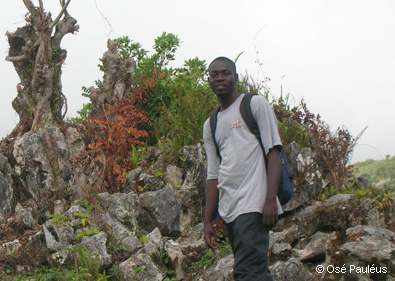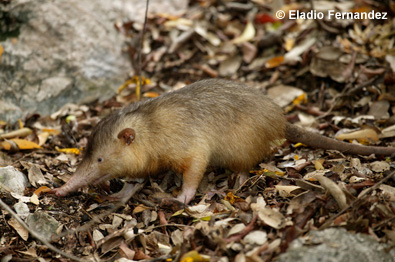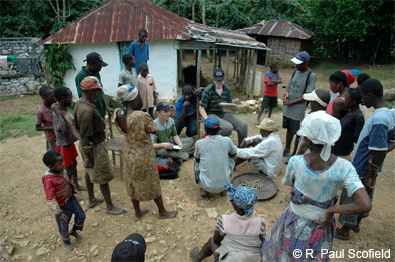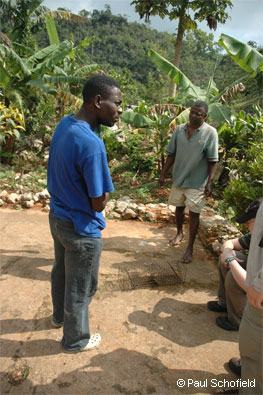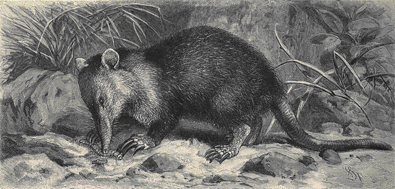Osé is an EDGE Fellow working on conservation of the Hispaniolan solenodon in Haiti. Here he reports on the findings from his EDGE Fellowship fieldwork in the Massif de la Hotte, in the south-western corner of Haiti:
Several questions have been asked about the survival of one of the two native Hispaniolan land mammals:
- Is the Haitian solenodon (Solenodon paradoxus) still surviving in the Massif de la Hotte, Haiti?
- Do people in the local community and the community around know about that fortune of this species and/or its importance in the biodiversity?
- Do they know about its existence and its status?
- Do they even care about its threat status and the consequences?
- Do they even know about the environment and its components?
To respond to those questions a pilot project ran, conducting sign surveys and interviews with the inhabitants to gather accurate information on the state of the species in the locality of the Massif de la Hotte (Duchity and surrounding communities), Haiti; and to look for the Hispaniolan solenodon pathways. A good campaign of the population awareness was carried out simultaneously, pointing out the state of the biodiversity in general, the state and threats of the Hispaniolan solenodon, and the consequences for future generation; trying to influence them of their responsibility toward the environment that they are part of and to avoid the extinction of the species.
Most of the ecologist scientists had concluded that the Hispaniolan solenodon was completely extinct in the locality of the Massif de la Hotte of Haiti. They came to that conclusion because of the environmental state of the country, where only less than 2 % forest is remaining. Fortunately, recent studies conducted by a group of British scientists had confirmed the existence of the species in the area.
The Hispaniolan solenodon (Solenodon paradoxis), an endemic mammal of Haiti, has been found in the region of Duchity of the Massif de la Hotte for the past ten years. Some scientists have been negative about its continued existence in Haiti because of all the threat factors seen in that region; they even envisaged its extinction in the years to come. But, recent studies conducted by Scientists from the UK under the supervision of the Zoological Society of London have shown that the Hispaniolan solenodon still exist in the Massif de la Hotte. The species is rather endangered because of all the threat for its habitat, but still survive. Lately, scientists have found several dead specimens of the species around the region of Duchity that confirmed the species survival; then, recent surveys in 2008 that have been conducted in the neighborhood proved the continued existence of the species.
To study the status of the species in that region, the ZSL scientists carried out an 11-day survey in April 2007; and they confirmed that the Hispaniolan solenodon still exist in that region after they have found three dead bodies of the solenodon. One of them was very fresh. Then, beginning in June 2008, I carried out a pilot project using the same method as the British scientists (sign surveys, interviews, tracking pathways of the species etc..). That mean villagers and subsistence farmer have been interviewed. They were asked some kind of contrast questions showing them some laminated posters of the Hispaniolan solenodon, the hutia, rats, mongoose and others.
In that investigation we questioned about 150 people and from that survey we can conclude that not more than 12% of the population of Duchity and the surrounded communities can make the difference among the Hispaniolan solenodon, the hutia, and the mongoose. They are very confused, especially about damages caused by different species. For those who can make the difference, hutias are more commonly recognised than solenodons. At the time the pilot project was running at the locality, about 2 % of the villagers and farmers are conscious about the threats facing by the species. A good environmental education program and community development projects are strongly recommended to help build awareness and the conserving of the biodiversity in the Massif de la Hotte.
One of the local people still had a dead solenodon that he wanted to sell to me. I asked him to guide me to the place he found it. The place was “Trou Bois” near ”Cadet”. It’s a rocky slope about 908, 9 m of altitude. According to that person, the dead body has been found in April 2008. Then, we have taken information for two other dead hutias.
From this research, we found out that the Hispaniolan solenodon still alive may be in minority in the Massif de la Hotte, even in lower altitude than usual. However, farmers and villagers confused the two native land mammals (solenodon and hutia). More than 12% of them cannot differentiate the two mammals and their damages. Because of that they considered the Hispaniolan solenodon as a pest trying to chase them out of their field; thinking that they are destroying their crop plantation (but, in fact, solenodon only eat plants very rarely).
Unfortunately, no one had studied yet the main factors that explained the continued existence of the Hispaniolan solenodon; but it’s an interesting subject. I hope scientists will be interested in that soon; then, will establish effective conservative program to protect the richness of the Massif de la Hotte that is so unique in its biodiversity; for birds, mammals and others. As it will be difficult to establish a conservative programme for the solenodon without thinking about the misery of the population, it will be great to run community development projects to help in the development of the local people so that they may consider the conservative programme.
If you would like to contribute to the conservation of EDGE species, then please become an EDGE Champion, or donate here.
